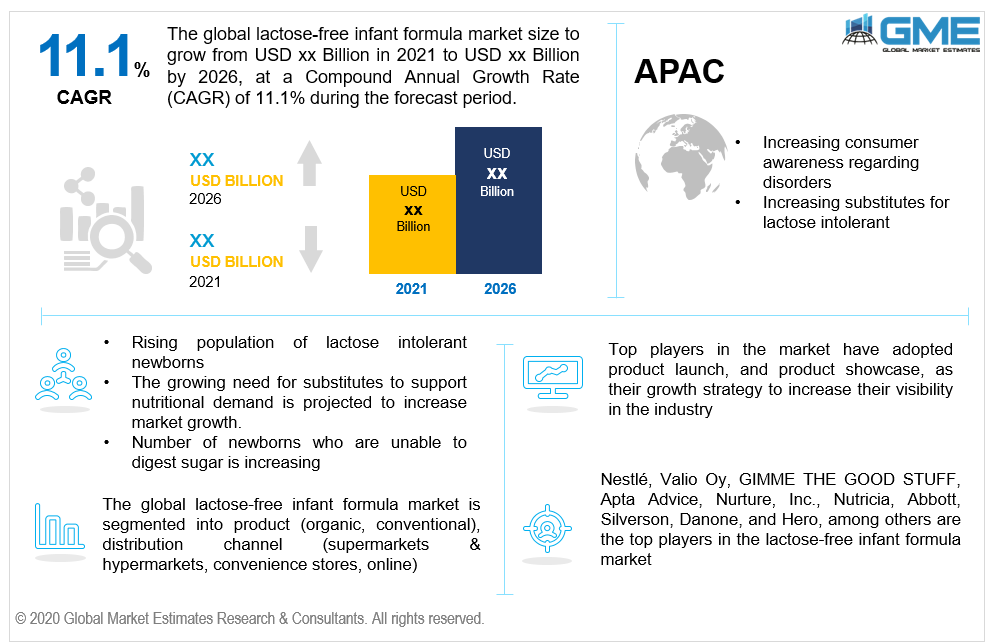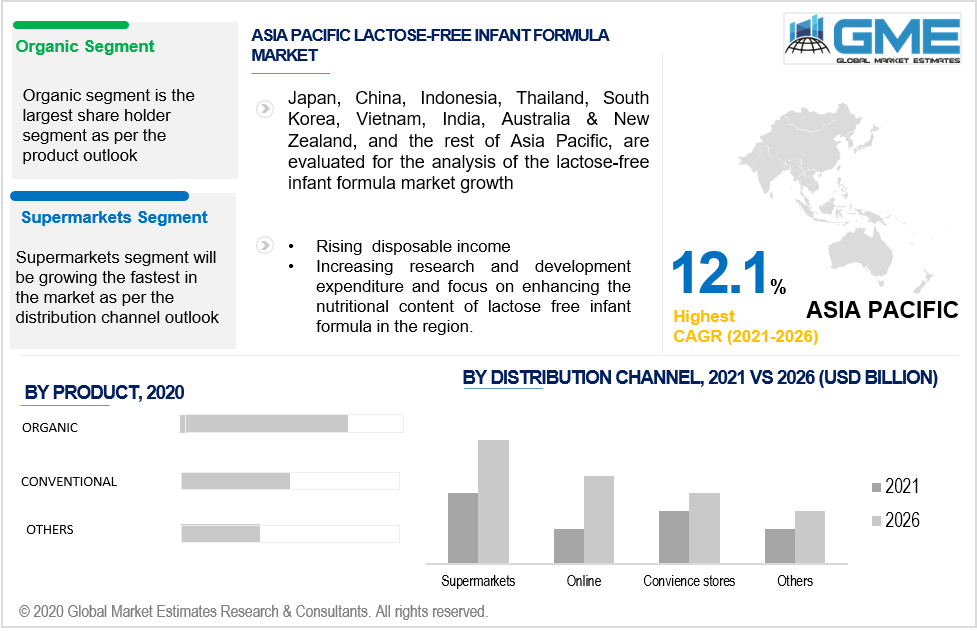
Global Lactose-Free Infant Formula Market Size, Trends & Analysis - Forecasts to 2026 By Product (Organic, Conventional), Distribution Channel (Supermarkets & Hypermarkets, Convenience Stores, Online), By Region (North America, Europe, Asia Pacific, MEA, and CSA), End-User Landscape, Company Market Share Analysis, and Competitor Analysis
Lactose-free baby formula is made for babies who are unable to produce an enzyme that aids in the digestion of lactose due to a genetic defect. In children, it also causes abdominal bloating, cramps, and diarrhoea. As a result, demand for lactose-free baby formula that is tailored to these consumers' needs has increased. The progress in the healthcare sector is also indicative of the growth of lactose-free infant formula. The development of new medicinal and pharmaceutical devices, including baby child nutritional formulae, has fueled demand for lactose-free infant formula. Lactose-free baby formulas are for babies who are unable to generate an enzyme that helps in the digestion of lactose naturally. The medical term for this disorder is lactose intolerance. As per a World Health Organization study, breastfeeding offers the most nutritional benefits to infants. However, manufacturers are focusing on developing lactose-free baby formulas due to a shortage of time among working women and an increase in the incidence of lactose intolerance among children.
The market drivers which contribute to the lactose-free infant formula market include the rising population of lactose intolerant newborns, as well as an increase in the number of working women. Companies are being compelled to enter this market by the increasing need for a replacement commodity to meet the population's nutritional needs. The demand is being driven by an increase in the number of lactose intolerant newborns, as their inability to digest sugar elements has increased over time. Premature babies with galactosemia, children with cow's milk protein allergies, and others are among the most common users of these formulas. Companies are being compelled to enter this market by the increasing need for a replacement commodity to meet the population's nutritional needs. These formulations are mostly made from lactose-free cow's milk. There are some brands of lactose-free diets that have had all the milk sugar extracted and replaced for fussy babies who suffer from colic and probably a slight lactose intolerance. The growing number of lactose-intolerant newborns is one of the major factors driving the global lactose-free infant formula market forward. Lactose intolerance refers to an infant's inability to absorb the sugars contained in milk. Lactose-free baby foods are most often used for infants with cow's milk protein deficiencies and newborn babies with galactosemias. Lactose-free baby formulas are made mostly from cow's milk that has had the lactose extracted. Increasing consumer awareness of the risks of chemical baby formulas is another aspect behind the development of the lactose-free infant formula industry. Several companies sell lactose-free infant formula products that substitute the milk sugar and replace it with corn syrup or some other vegetable syrup for children with moderate lactose intolerance. In the global lactose-free infant formula market, this is a significant trend.

Based on the product, the market is segmented into organic, and conventional. During the forecast era, the organic formula is expected to dominate. On a global scale, it has been found that consumers tend to buy quality infant nutrition goods. Natural goods, on the other hand, are government-certified, which encourages consumers to buy them. The category is growing as consumers become more conscious of the negative effects of chemically synthesized baby formula.
The conventional segment has the highest demand. Conventional baby formula is both inexpensive and effective in reducing diarrhea in infants. These drugs are less expensive than organic products. To meet the needs of customers, companies are broadening their product lines with innovative products.
Based on the distribution channel, the market is segmented into supermarkets & hypermarkets, convenience stores, and online. During the forecast era, the supermarket sector is expected to dominate due to the accessibility of a diverse variety of products with various options such as authentication and product screening. The segment's revenues have risen as a result of increased promotional and advertising campaigns. Furthermore, the retail sector is evolving as the number of local brands in the industry grows. Consumers tend to shop in this category because it offers a wide variety of options as well as the opportunity to search product specifics before making a purchase. The layout of the store and advertising promotions by top brands have also boosted sales volume in the supermarkets and hypermarkets community. The market has been driven by the growth of integrated retail sectors, which have provided enough space and exposure for established as well as local brands to sell their products.
The fastest-growing medium is expected to be the online sector. One of the key factors for the growth in the online sector is the increasing adoption of e-commerce or digital. Consumers prefer online services because of features such as doorstep delivery, discounts, and other perks. The demand for lactose-free baby formula is increasing as a result of these factors.

As per the geographical analysis, the market can be classified into North America (the US, Canada, and Mexico), Asia Pacific (India, China, Japan, Malaysia, Singapore, and Rest of Asia Pacific), Europe (Germany, United Kingdom, Italy, France, Spain, Netherlands, and Rest of Europe), Middle East & Africa and Central South America.
Because of the large number of lactose-intolerant babies in this country, the European market accounts for the largest revenue share in the global lactose-free infant formula market. Ireland produces more than 80% of the base powder used in lactose-free infant formula manufacturing in Europe. Over the forecast period, the lactose-free infant formula market in Latin America is expected to rise at the fastest rate. Individuals' disposable income is growing, particularly in developing economies, and the number of lactose-intolerant infants is increasing in Latin America, boosting the market's development.
Nestlé, Valio Oy, GIMME THE GOOD STUFF, Apta Advice, Nurture, Inc., Nutricia, Abbott, Silverson, Danone, and Hero, among others are the top players in the lactose-free infant formula market.
Please note: This is not an exhaustive list of companies profiled in the report.
We value your investment and offer free customization with every report to fulfil your exact research needs.
The Global Lactose-Free Infant Formula Market has been studied from the year 2019 till 2026. However, the CAGR provided in the report is from the year 2021 to 2026. The research methodology involved three stages: Desk research, Primary research, and Analysis & Output from the entire research process.

The desk research involved a robust background study which meant referring to paid and unpaid databases to understand the market dynamics; mapping contracts from press releases; identifying the key players in the market, studying their product portfolio, competition level, annual reports/SEC filings & investor presentations; and learning the demand and supply-side analysis for the Lactose-Free Infant Formula Market.

The primary research activity included telephonic conversations with more than 50 tier 1 industry consultants, distributors, and end-use product manufacturers.

Finally, based on the above thorough research process, an in-depth analysis was carried out considering the following aspects: market attractiveness, current & future market trends, market share analysis, SWOT analysis of the company and customer analytics.

Tailor made solutions just for you
80% of our clients seek made-to-order reports. How do you want us to tailor yours?
OUR CLIENTS